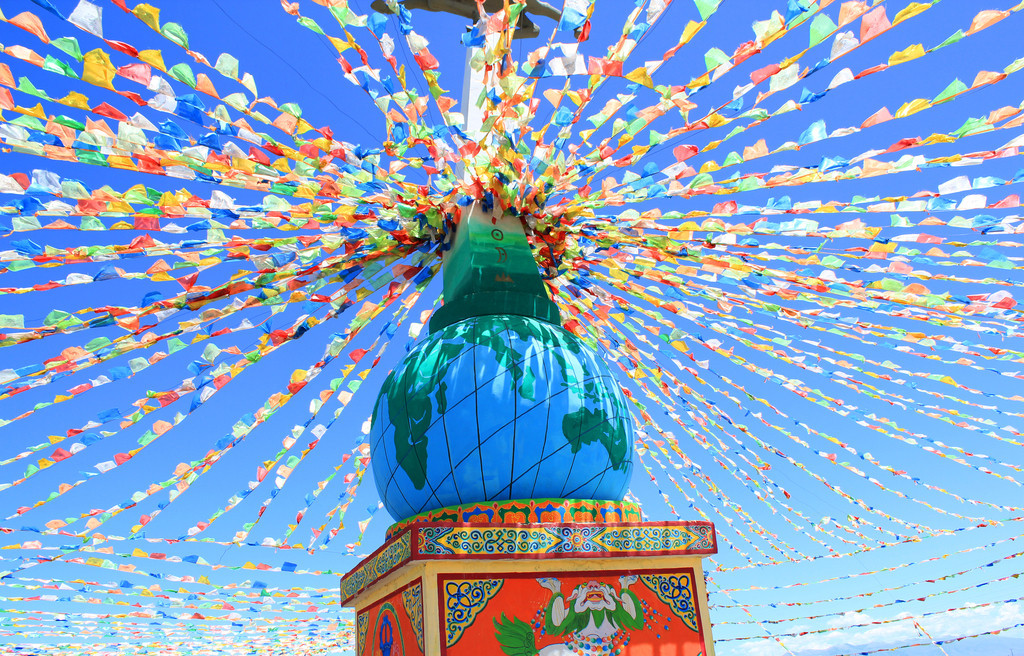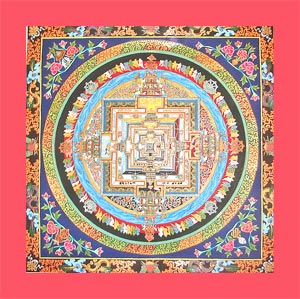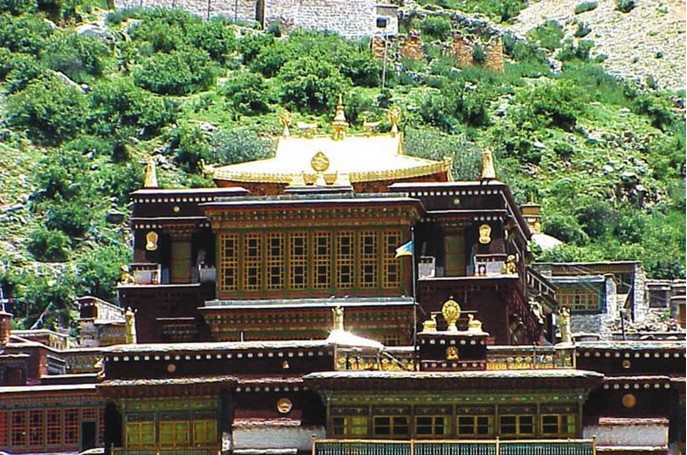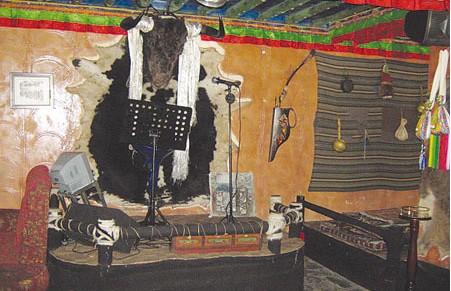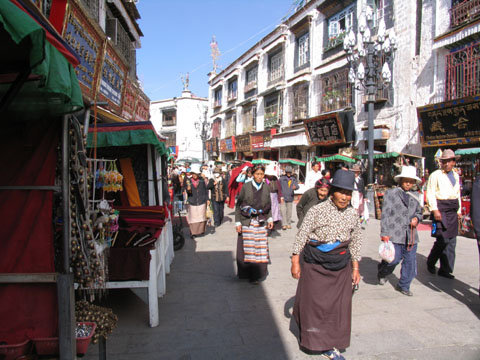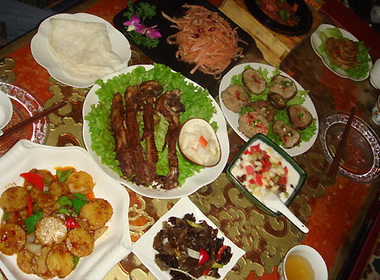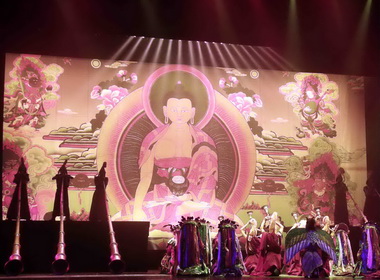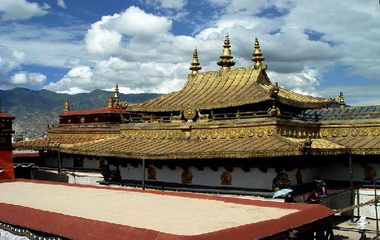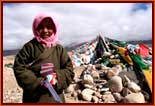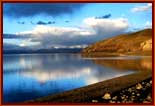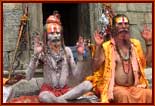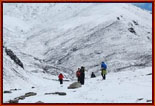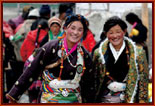Tibetan Funeral
There is neither immortality nor unified annotation about death. To most people in the world, death is regarded as a matter of horror and awe. But the Tibetan people do not think quite that way.
The funeral is the last imperative step of a life, and a ceremony for people to lament the dead. Funeral customs reflect the political, religious, economic and cultural aspects of a society, and are a constituent of folk culture.
On the Qinghai-Tibet Plateau, the nonparallel natural and cultural environment has incubated the same nonparallel funeral customs. The Tibetan funeral customs have been greatly influenced by Tibetan Buddhism and Bon Religion. Here exist almost all kinds of funeral ways, namely, inhumation, incineration, stupa burial, celestial burial, water burial, cliff burial, tree burial, stone coffin burial and multi-person burial, etc, each having its special existent time, special existent time, scope and sense. Inhumation is said to be the earliest practice in Tibet. The stupa burial and incineration are regarded as noble ways; the former in particular was only for the successive Dalai Lamas and Panchan Lamas as well as a few grand Living Buddhas, i.e. being buried in gold and silver stupas; while the latter is for ordinary shamen and noblemen. However, in the forested regions such as Nyingchi Prefecture, incineration is also practiced by the ordinary people. The water burial is mainly for the poor, dead of disease and children, etc. Yet above all, the celestial burial is the most accepted and practiced funeral practice in Tibet.
The Celestial Burial
There are two different explanations about the origin of the celestial burial. One says it is purely native; while another says in came from India or Central Asia. However it is generally recognized that its evolvement has gone through two phases. The first one is the period of so-called aboriginal celestial burial, when people unconsciously left the dead body in the wild. Till the period between the 11th and 12the century, influenced by the Buddhist doctrines, the celestial burial had gradually started with rituals, hence started the period of so-termed ritualized celestial burial. Since then the rituals have become all the more regularized. Now it is predominantly the most prevailing funeral practice among all in Tibet.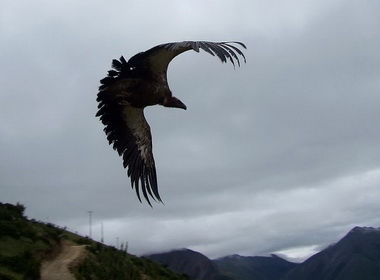
A complete set of funeral procedures should start while the person's life still lingers. The family members would feed the dying person with a tablet made of rare Tibetan herbs mixed with burnt ashes of the drapery, hair and nails of Living Buddhas, which is said to be able to help the dying person cut off some intrinsic qi, i.e. the human appetites, and let the soul leave peacefully. Meanwhile Lamas would be commissioned to chant scripture, so as to help the dying person to get rid of anguish and fear at the last moments. Notably the ladies and children generally are not allowed to approach the dying person, because it is said that will disturb his mood and influence his smooth transmigration.
As soon as the person dies, a piece of white cloth will be used to cover his face, and nobody is allowed to touch or move the dead body from then on. At the same time, Lamas will be commissioned to hold a ceremony called Paowa, that is said to help the soul's exodus from the skull and rise to heaven, instead of expelling it from the asshole and falling to hell.
During the funeral preparation period, a pottery jar will be hung on the doorway of the dead person's home as a sign of mourning. Meanwhile some cypress branches will be burned in the jar, adding in some tsamba, cattle or sheep's blood, meat and fat, as well as the milk, cheese and butterfat, a way of serving meals to the dead. Throughout this period, all friends, relatives and neighbors shall not sing, dance or make any fun. Cats, dogs, and other livestock are to be strictly kept away from the dead body.
Wizards are also commissioned to divine and select appropriate time of the funeral, which is usually at 4 or 5 o’clock in the early morning on the fourth or fifth day after the time of death. The body is bent into a shape like a fetus in pregnancy, with his harms and legs being bound together. The body, covered with a white tweed, will be carried on back of a family member, and moved towards the funeral yard for a certain distance, and then be handed over to a professional body carrier, but by no means will it be placed on the earth on the way, or else the soul of the dead will wader about there.
On arriving, people will burn bunches of cypress branches to notify the divine vultures. The rising smoke summons the vultures flocking there. Now the celestial burial master begins to cut apart the corpse. He will incise it from its back, take out the bowels, separate the muscle from the bones, and crush the skeleton with stone, then mix this with tsampa. Then the master will first feed the vultures with the bowels, then with the bones and at last with the meats. If the vultures eat all with nothing remaining, it means the dead had not committed any sin while living, and his soul will be guided to 'heaven'? If white vultures eat first, it is regarded as the most auspicious sign; while if the vultures eat nothing or eat only a part, then the remains will be burned, and the ashes will be spread over. In this case, the family members should commission monks to chant scripture, and release the soul from purgatory. Afterwards, the deputies of the family will treat the master with meat and wine. Yet within certain period of time, the master is not allowed to visit the family of the dead to avoid taking the soul back his home.
However, the rules for celestial burial masters vary greatly with places. The above-said is that of the area near Lhasa.
Inhumation
Inhumation or entombment is an age-old funeral ritual in Tibet. According to the findings from many Neolithic archeological digs scattered on the Qinghai-Tibet Plateau, inhumation prevailed in remote antiquity, and took the ruling position during the Tubo Kingdom period. It had evolved to its peak and become the noblest funeral practice when the Tubo Kingdom was also in full flourish. The magnificent royal tombs of the kingdom still lie in Qonggyai County of Shannan Prefecture today. The complicated funeral rituals and numerous burial accessories in that time also reveal its past brilliance. However with decay of the kingdom, the riotous commoners and slaves smashed up the royal tombs; in addition to the dissemination of the Buddhism, it gave the way to celestial burial.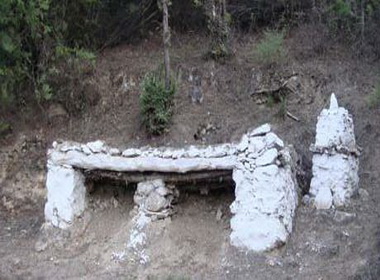
There from, inhumation is gradually taken as a humble burial way mainly for dead of infectious disease or accident or for the outlanders, who are considered as 'impure', thus whose body can not be dedicated to the flying deities (the vultures) and the water deities (the fish). Hence they are not qualified for celestial burial or water burial. Rather they are destined to be buried underground.
Water Burial
In Tibet, water burial is considered as a derivative of the celestial burial. Its position is two-fold in different areas. On one hand in the central region of the Tibetan culture, where celestial burial is prevails, water burial is thus only for the poor people, such as those who have no kin, or beggars, etc. Its rituals are also simple. People simply carry the body to the riverside, dismember it and throw it into water; or sometimes they do not dismember it, just pack it and then throw into water. Hence, water burial is seen as a lower class ritual there.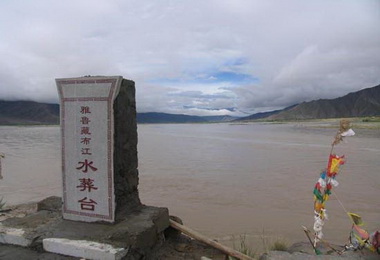
On the other hand, in the marginal areas of the Tibetan culture, especially at the deep valleys in Southern Tibet where there are few vultures available, water burial becomes the main way for the local people. They do not think of it as being inferior to celestial burial, since both are for dedication to the deities, whether in the air or under water. As a result, the local people do not eat fish. Naturally, the rituals of the water burial in these areas appear rather complicated, e.g. having special water burial masters and prescriptive water burial fields. The process and complete package of rituals is similar to that of celestial burial. For example, monks are commissioned to chant scripture and release the souls from purgatory; the funerals will be held after three to five days of death; wizards are commissioned to divine and select the date of funeral, etc.
Incineration
In Tibet, water burial is considered as a derivative of the celestial burial. Its position is two-fold in different areas. On one hand in the central region of the Tibetan culture, where celestial burial is prevails, water burial is thus only for the poor people, such as those who have no kin, or beggars, etc. Its rituals are also simple. People simply carry the body to the riverside, dismember it and throw it into water; or sometimes they do not dismember it, just pack it and then throw into water. Hence, water burial is seen as a lower class ritual there.
On the other hand, in the marginal areas of the Tibetan culture, especially at the deep valleys in Southern Tibet where there are few vultures available, water burial becomes the main way for the local people. They do not think of it as being inferior to celestial burial, since both are for dedication to the deities, whether in the air or under water. As a result, the local people do not eat fish. Naturally, the rituals of the water burial in these areas appear rather complicated, e.g. having special water burial masters and prescriptive water burial fields. The process and complete package of rituals is similar to that of celestial burial. For example, monks are commissioned to chant scripture and release the souls from purgatory; the funerals will be held after three to five days of death; wizards are commissioned to divine and select the date of funeral, etc.
Stupa Burial
Stupa burial is a funeral practice of the highest order. Only grand Living Buddhas and very few noblemen can be qualified. When they pass away, their bodies will undergo antiseptic treatment, mummification or preservation, and then reside inside of the gold or silver stupa for worship.
In Tibet, there are many ways to undertake the antiseptic treatment. One of them is to immerse and clean they body with a sort of potion mixed with perfumes at first, and then apply salts on the body time and again to dehydrate the body. These salt lumps mixed with blood and body water of the living Buddha, called Duntsa, are valued as shrines by the Tibetan people, said being able to cure all and to expel disasters and evils. Some monasteries offer them to their honored guests as gifts. This author was presented with a piece of Duntsa came from the 10th Panchan Lama by the senior monk of the Tashilunpo Monastery. Later on the author shifted it to a friend of his and it was appreciated by the latter greatly. Another way is to bury the body with the dry sand, which will absorb all the water from the body in about three years. The third way is to bake the body in a room with a stove underground, the floor of which will be paved with a thick layer of specific powders. The body shall be pre-treated beforehand, i.e. its bowels are taken out; a special kind of paint is filled in...
Afterwards, the body of the VIP will be plated with gold sheet, and covered with saffron and perfume, etc. After the passing away of the 10th Panchan Lama, the Tibetan Regional Government provided 108 species of rare medicinal herbs, such as saffron, borneol land so on, altogether about 500kg for the treatment. The last step is to tidy up the body, dress it up and move it into the stupa for long-term preservation and worship.
The stupa consists of three parts: the base, vase and wheel. It can be also classified according to the materials used, i.e. gold, silver, bronze, wood and clay stupas for the Living Buddha or senior monks of different status. Generally speaking, the gold stupas are for the successive Dalai Lamas and Panchan Lamas; while the silver ones are for such eminent monks like the Abbot of Gandan Monastery. The stupas are often stored in the hassle of the monastery.
Other Burial Practices
Besides the above-mentioned ways as a mainstay, there are some other minor practices.
Cliff Burial
The typical examples are those existing in the Gyirong Tsangpo River valley in Southern Tibet, where water burial and incineration are also coexistent. When a person dies, eminent monks will be commissioned to divine and to decide the rituals and methods of the funeral. If cliff burial is decided, the body will be coated with ghee or milk, and treated with salts and perfume, and then sealed in a small cube-shaped wooden crate. On some occasion there are not even any utensils needed: the dressed body is simply bound with bands like a ball. The burial site is usually selected in places far away from human habitation, especially in the cliffs standing aside of torrential river valleys. Natural caves will often be used, which are usually 50 to 200 meters higher than the ground nearby, or 300 to 500 meters higher than the river level. There are also some caves dug by people. Usually the higher the cave is located, the higher status the departed has, and the more solemn the ceremony will be.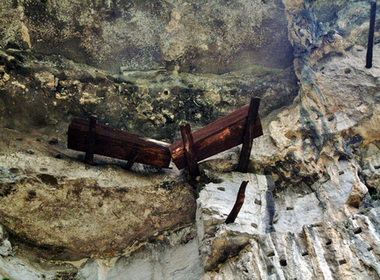
Tree Burial
Primarily practiced in Nyingchi Prefecture, it is mainly for aborted children. The process is to clean the body with salt solution, then place it into a wooden crate, cask or bamboo basket, and carry it to forested area north-facing on the mountain, and hang on a great tree, so the other children of the family will be free from being harmed again.
Furthermore, there are hanging coffin burials, multi-person burials and stone coffin burials, etc.


